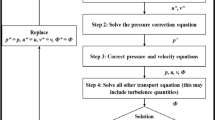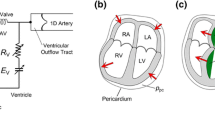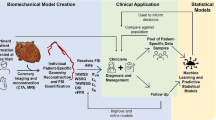Abstract
To reveal how the matching models of the left ventricle and its afterload affect the pressure and flow in the aortic mt, the differences between the measured pressure and flow waveforms and those determined by three kinds of matching model were compared. The results showed that, compared with the results by both matching models 1 and 2, the pressure and flow waveforms determined by matching model 3 established in this work were in the closest agreement with the corresponding experimental waveforms, therefore indicating that matching model 3 was a matching model that closely and rationally characterized the match between the left ventricle and the systemic artery.
Similar content being viewed by others
References
Minlor, W.R.,Hemodynamics, London: Willian & Wilkins Press, 1982.
Myhre, E.S.P., Johansen, A., Piene, H., Optimal matching between canine left ventricle and afterload,Am. J. Physiol., 1988, 363: H1051.
Sunagawa, K., Maughan, W.L., Burkhoff, D.et al., Left ventricular interaction with arterial load studied in isolated canine ventricle,Am. J. Physiol., 1983, 245: H773.
Horn, G.J., Westerhof, N., Elzinga, G., Optimal power generation by the left ventricle: A study in the anesthetized open thorax cat,Cric. Res., 1985, 56: 252.
Suga, H., Igarashi, Y., Yarnada, O.et al., Mechanical efficiency of the left ventricle as a function of preload, afterload, and contractility,Heart and Vessel, 1985, 1: 3.
Hämäläinen, J.J., Hämäläinen, R.P., Energy cost minimization in left ventricular ejection: an optimal control model,J. Appl. Physiol., 1986, 61: 1972.
Suga, H., Minimal oxygen consumption and optimal contractility of the heart: Theoretical approach to principle of physiological control of contractility,Bull. Math. Biol., 1979, 41: 139.
Ding, G., Liu, Z., Dynamic principle for interaction between heart and arterial system,Acta Mech. Sinica, 1992, 8: 237.
Liu, Z., Li, X.,Windkessel Theory and Its Application in Curdiovascular Ana1yses (in Chinese), Beijing: Science Press, 1987.
Author information
Authors and Affiliations
Additional information
Project supported by the National Natural Science Foundation of China.
Rights and permissions
About this article
Cite this article
Liu, Z., Wu, C. Matching models of left ventricle and systemic artery. Sci. China Ser. C.-Life Sci. 40, 470–476 (1997). https://doi.org/10.1007/BF03183584
Received:
Issue Date:
DOI: https://doi.org/10.1007/BF03183584




